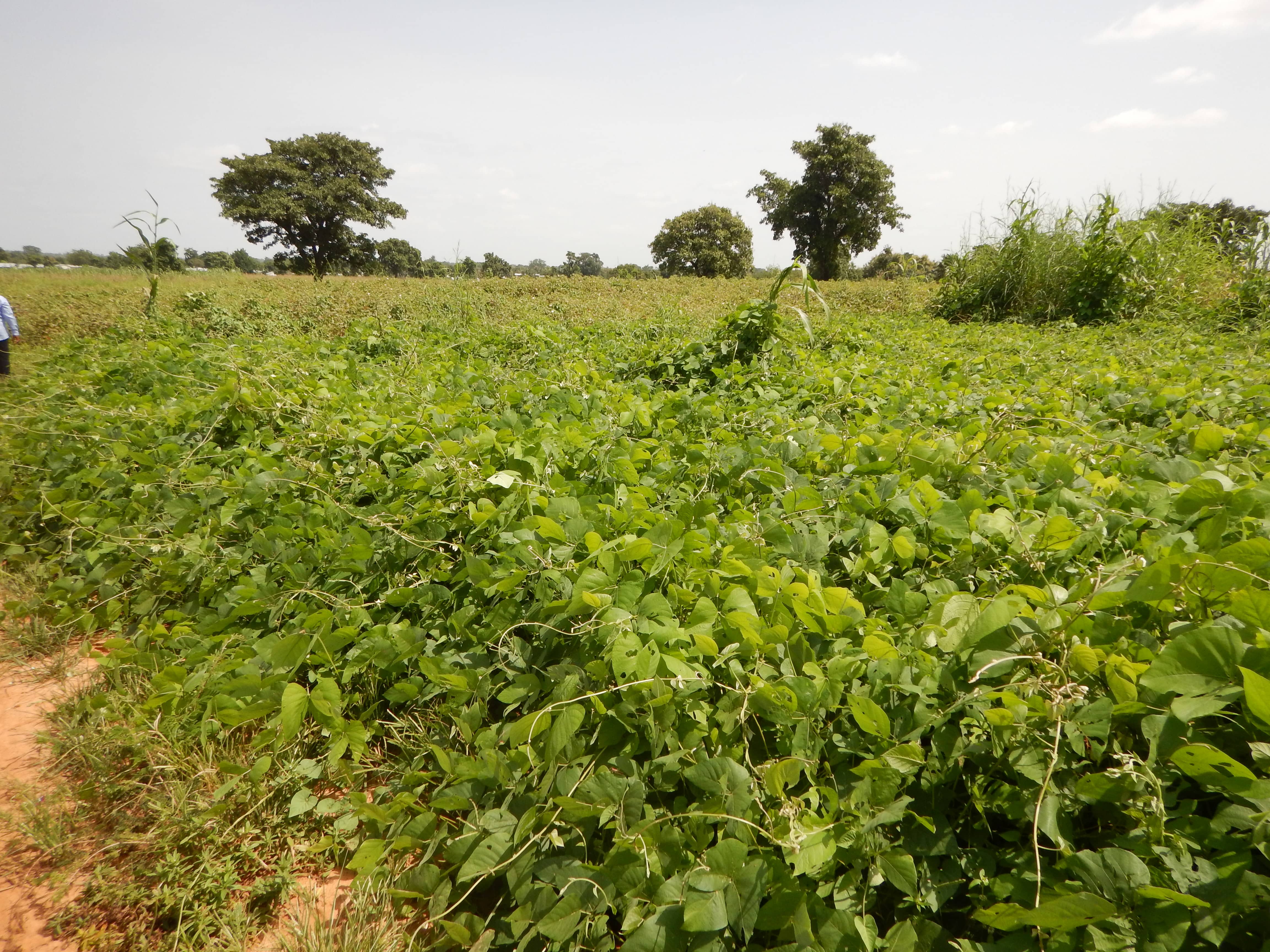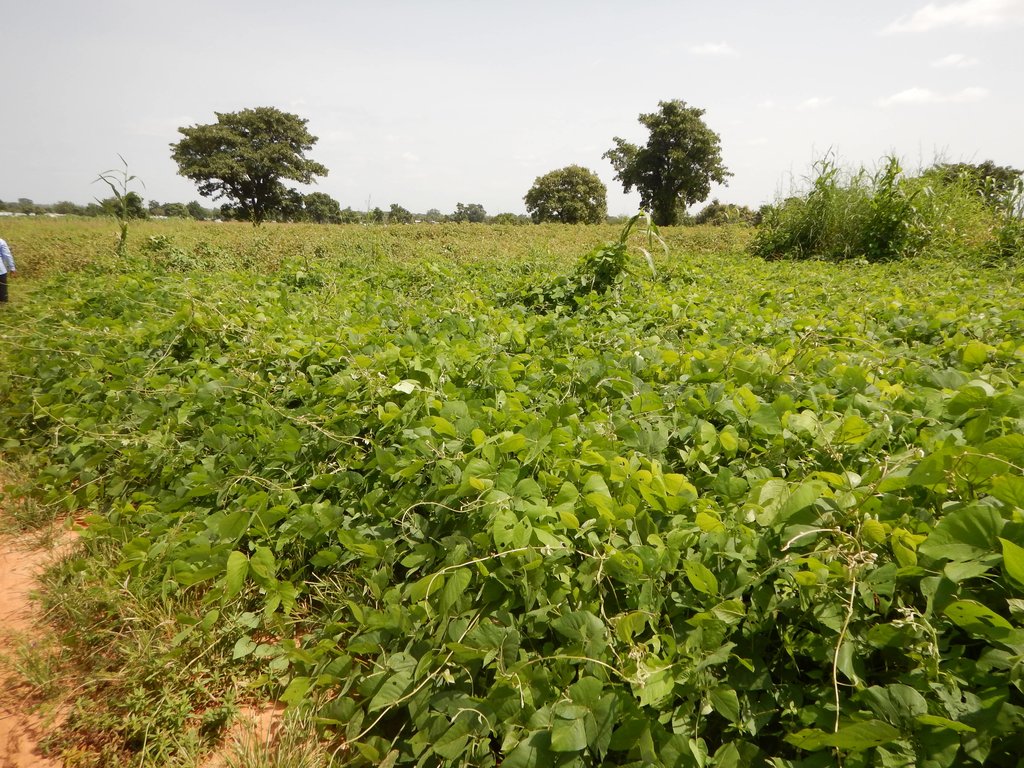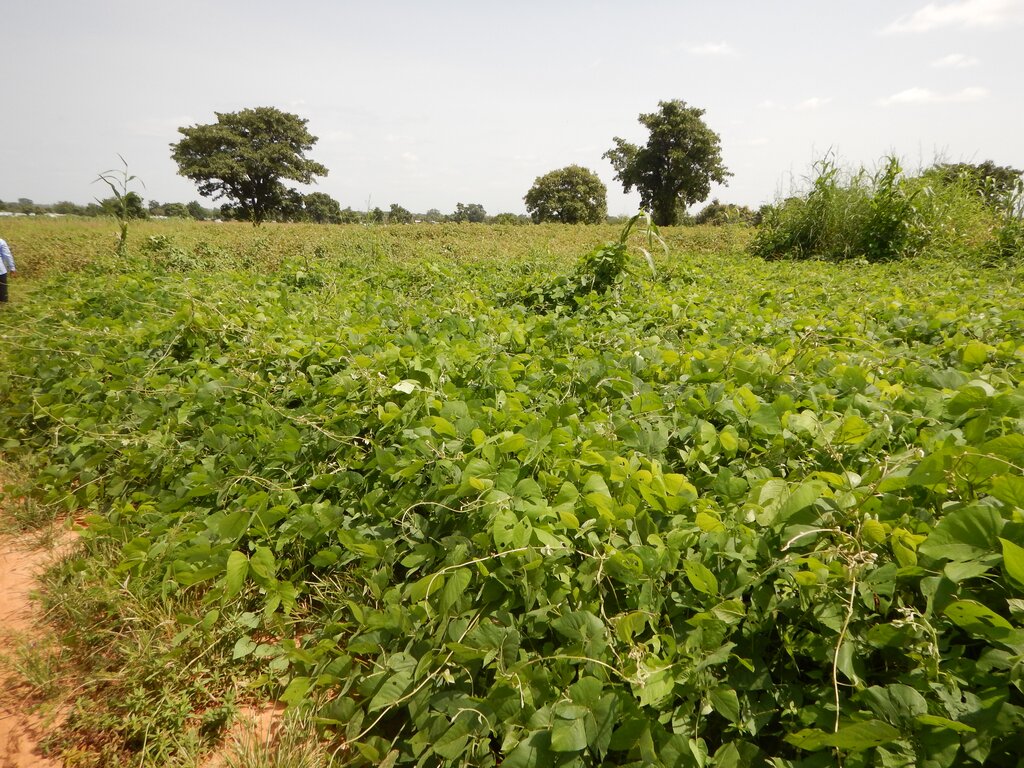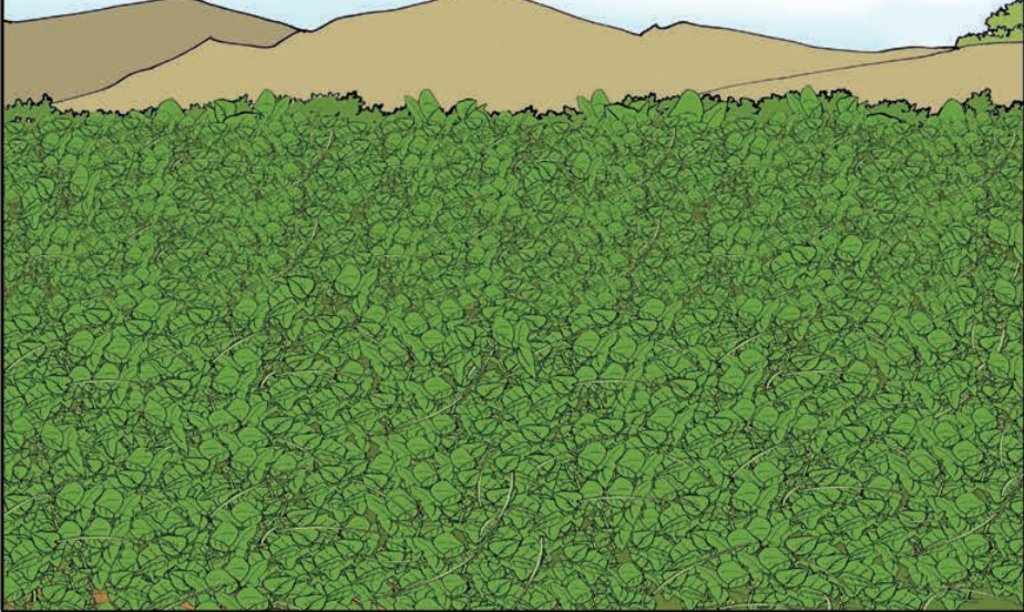Mucuna as a cover crop to improve soil fertility [Benin]
- Creation:
- Update:
- Compiler: Gatien AGBOKOUN CHRISTOPHE
- Editors: Siagbé Golli, Abdoul Karim MIEN, DOSSOU-YOVO bernardin, Oscar Assa KINDEMIN, Bona Ibouratou DAFIA, Tabitha Nekesa, Ahmadou Gaye
- Reviewers: Sally Bunning, Rima Mekdaschi Studer, William Critchley
technologies_6680 - Benin
View sections
Expand all Collapse all1. General information
1.2 Contact details of resource persons and institutions involved in the assessment and documentation of the Technology
Key resource person(s)
land user:
DAGAN Lucien
CRADIB ONG
Benin
SLM specialist:
SEGNONAN Expédit
CRADIB ONG
Benin
SLM specialist:
GBEGNON Rokard
CRADIB ONG
Benin
Name of project which facilitated the documentation/ evaluation of the Technology (if relevant)
Soil protection and rehabilitation for food security (ProSo(i)l)Name of the institution(s) which facilitated the documentation/ evaluation of the Technology (if relevant)
GIZ Bénin (GIZ Bénin) - Benin1.3 Conditions regarding the use of data documented through WOCAT
The compiler and key resource person(s) accept the conditions regarding the use of data documented through WOCAT:
Yes
1.4 Declaration on sustainability of the described Technology
Is the Technology described here problematic with regard to land degradation, so that it cannot be declared a sustainable land management technology?
No
2. Description of the SLM Technology
2.1 Short description of the Technology
Definition of the Technology:
Mucuna (Mucuna pruriens) is an annual herbaceous legume used as a cover crop to restore soil fertility. Beyond its nitrogen-fixing properties, its dense foliage is a living mulch that helps replenish the soil's organic matter content, capturing rainwater, protecting the soil from erosion and keeping weeds under control.
2.2 Detailed description of the Technology
Description:
Mucuna (Mucuna pruriens) is planted by farmers as a cover crop to rejuvenate infertile, weed-infested soils, such as those infested by Imperata sp. and Striga sp., or simply to improve soil of poor or moderately fertility. It thrives in diverse soil types, including sandy, clayey, and highly acidic soils. While it is sensitive to waterlogged conditions, the Cochinchinensis variety (white in colour) exhibits tolerance to temporary flooding.
For pure stand cultivation, farmers typically sow two seeds per hole, spaced at 0.80 meters between rows and 0.40 meters within rows, requiring 30 kilograms per hectare of seed. Seeding is timed to coincide with the onset of the rainy season, with the plant's growth cycle varying from 100 to 300 days.
After successful emergence, farmers typically weed Mucuna fields once or twice, depending on the extent of weed growth. This allows the legume to establish itself effectively, forming a dense cover that outcompetes weeds. To boost productivity, farmers opt to retain trees within the fields. These trees serve as natural supports for Mucuna to climb, enhancing the number of inflorescences per plant, the quantity of seeds per pod, and the germination rate of harvested seeds. Mucuna completes its life cycle after producing seeds.
Farmers have reported improved yields for crops planted after Mucuna. For instance, maize yields typically range from 2.5 to 3 tonnes per hectare when cultivated on land previously planted with Mucuna, compared to 1.5 tonnes previously. This performance has earned Mucuna the name "Miracle Plant" among farmers. In summary, Mucuna demonstrates positive effects on various soil components, including good moisture retention, sunlight protection, enhanced microbial activity, and organic matter enrichment. As a result, farmers notice that the soil is well aerated, loose and porous. The leaves are good fodder for livestock, especially for housed sheep.
The majority of farmers prefer Mucuna for its efficacy in suppressing weeds such as striga and Imperata indica, as well as its capability to replenish soil nutrients. Nonetheless, Mucuna has certain drawbacks, notably serving as a habitat for reptiles, including snakes.
2.3 Photos of the Technology
2.5 Country/ region/ locations where the Technology has been applied and which are covered by this assessment
Country:
Benin
Region/ State/ Province:
Donga
Further specification of location:
Bantè
Specify the spread of the Technology:
- evenly spread over an area
If the Technology is evenly spread over an area, specify area covered (in km2):
1.0
Is/are the technology site(s) located in a permanently protected area?
No
Map
×2.6 Date of implementation
Indicate year of implementation:
2016
2.7 Introduction of the Technology
Specify how the Technology was introduced:
- through projects/ external interventions
Comments (type of project, etc.):
Mucuna was introduced to the commune of Bantè through ProSOL/Benin.
3. Classification of the SLM Technology
3.1 Main purpose(s) of the Technology
- improve production
- reduce, prevent, restore land degradation
- conserve ecosystem
- preserve/ improve biodiversity
- create beneficial economic impact
3.2 Current land use type(s) where the Technology is applied
Land use mixed within the same land unit:
No

Cropland
- Annual cropping
Annual cropping - Specify crops:
- cereals - maize
- oilseed crops - groundnuts
Number of growing seasons per year:
- 1
Specify:
Producers harvest Mucuna only once a year since there is only one rainy season.
Is intercropping practiced?
No
Is crop rotation practiced?
Yes
If yes, specify:
Following the planting of Mucuna, farmers initiate a crop rotation system on the Mucuna-planted plots, alternating between maize and groundnuts.
3.3 Has land use changed due to the implementation of the Technology?
Has land use changed due to the implementation of the Technology?
- Yes (Please fill out the questions below with regard to the land use before implementation of the Technology)
Land use mixed within the same land unit:
No

Cropland
- Annual cropping
Annual cropping - Specify crops:
- cereals - maize
- oilseed crops - groundnuts
Is crop rotation practiced?
Yes
If yes, specify:
Maize is rotated with groundnuts.
3.4 Water supply
Water supply for the land on which the Technology is applied:
- rainfed
3.5 SLM group to which the Technology belongs
- rotational systems (crop rotation, fallows, shifting cultivation)
- improved ground/ vegetation cover
- integrated soil fertility management
3.6 SLM measures comprising the Technology

agronomic measures
- A1: Vegetation/ soil cover
- A2: Organic matter/ soil fertility
- A3: Soil surface treatment
A3: Differentiate tillage systems:
A 3.1: No tillage

management measures
- M1: Change of land use type
3.7 Main types of land degradation addressed by the Technology

soil erosion by water
- Wt: loss of topsoil/ surface erosion

soil erosion by wind
- Et: loss of topsoil

chemical soil deterioration
- Cn: fertility decline and reduced organic matter content (not caused by erosion)

biological degradation
- Bc: reduction of vegetation cover
- Bq: quantity/ biomass decline
- Bl: loss of soil life
3.8 Prevention, reduction, or restoration of land degradation
Specify the goal of the Technology with regard to land degradation:
- reduce land degradation
- restore/ rehabilitate severely degraded land
4. Technical specifications, implementation activities, inputs, and costs
4.1 Technical drawing of the Technology
Technical specifications (related to technical drawing):
In our region, the annual rainfall is 1323 mm and average temperatures during the growing season range around 19.5°C from May to October. These conditions fall within the optimal range of 1000 to 2500 mm of rainfall and temperatures between 19 to 27°C, which are favorable for the growth of the Mucuna plant.
For planting, we adopt a spacing arrangement of 0.4m x 0.8m between seedlings, both within clusters and across rows. During the sowing process, 2 to 3 seeds are typically placed per planting bed, resulting in an average density ranging from 23,437 to 93,750 plants per hectare. The recommended quantity of seeds for one hectare is approximately 25 to 30 kg. For optimal growth and development, it is advisable to sow the seeds between June and July at the latest.
Author:
ProSOL Bénin
4.2 General information regarding the calculation of inputs and costs
Specify how costs and inputs were calculated:
- per Technology area
Indicate size and area unit:
1ha
other/ national currency (specify):
CFA F
If relevant, indicate exchange rate from USD to local currency (e.g. 1 USD = 79.9 Brazilian Real): 1 USD =:
615.0
4.3 Establishment activities
| Activity | Timing (season) | |
|---|---|---|
| 1. | Clearing | May-June |
| 2. | Ploughing | June-July |
| 3. | Seeding | June-July |
4.4 Costs and inputs needed for establishment
| Specify input | Unit | Quantity | Costs per Unit | Total costs per input | % of costs borne by land users | |
|---|---|---|---|---|---|---|
| Labour | Clearing | ha | 1.0 | 17500.0 | 17500.0 | 100.0 |
| Labour | Ploughing | ha | 1.0 | 25000.0 | 25000.0 | 100.0 |
| Labour | Seeding | ha | 1.0 | 10000.0 | 10000.0 | 100.0 |
| Labour | ha | 1.0 | 20000.0 | 20000.0 | 100.0 | |
| Equipment | 100.0 | |||||
| Equipment | 100.0 | |||||
| Equipment | Daba | Unit | 1.0 | 4000.0 | 4000.0 | 100.0 |
| Equipment | Hoe | Unit | 1.0 | 3000.0 | 3000.0 | 100.0 |
| Plant material | Seeds | Kilogram | 30.0 | 500.0 | 15000.0 | |
| Total costs for establishment of the Technology | 94500.0 | |||||
| Total costs for establishment of the Technology in USD | 153.66 | |||||
4.5 Maintenance/ recurrent activities
| Activity | Timing/ frequency | |
|---|---|---|
| 1. | Weeding | July-August |
| 2. | Harvest | November-December |
| 3. | Threshing | December |
| 4. | Firebreaking | November-December |
4.6 Costs and inputs needed for maintenance/ recurrent activities (per year)
| Specify input | Unit | Quantity | Costs per Unit | Total costs per input | % of costs borne by land users | |
|---|---|---|---|---|---|---|
| Labour | Weeding | ha | 1.0 | 20000.0 | 20000.0 | 100.0 |
| Labour | Harvest | ha | 1.0 | 12500.0 | 12500.0 | 100.0 |
| Labour | Threshing | ha | 1.0 | 12500.0 | 12500.0 | 100.0 |
| Labour | Firewalling | ha | 1.0 | 12500.0 | 12500.0 | 100.0 |
| Total costs for maintenance of the Technology | 57500.0 | |||||
| Total costs for maintenance of the Technology in USD | 93.5 | |||||
4.7 Most important factors affecting the costs
Describe the most determinate factors affecting the costs:
Paid labour for harvesting is a limiting factor.
5. Natural and human environment
5.1 Climate
Annual rainfall
- < 250 mm
- 251-500 mm
- 501-750 mm
- 751-1,000 mm
- 1,001-1,500 mm
- 1,501-2,000 mm
- 2,001-3,000 mm
- 3,001-4,000 mm
- > 4,000 mm
Specify average annual rainfall (if known), in mm:
1323.00
Agro-climatic zone
- sub-humid
5.2 Topography
Slopes on average:
- flat (0-2%)
- gentle (3-5%)
- moderate (6-10%)
- rolling (11-15%)
- hilly (16-30%)
- steep (31-60%)
- very steep (>60%)
Landforms:
- plateau/plains
- ridges
- mountain slopes
- hill slopes
- footslopes
- valley floors
Altitudinal zone:
- 0-100 m a.s.l.
- 101-500 m a.s.l.
- 501-1,000 m a.s.l.
- 1,001-1,500 m a.s.l.
- 1,501-2,000 m a.s.l.
- 2,001-2,500 m a.s.l.
- 2,501-3,000 m a.s.l.
- 3,001-4,000 m a.s.l.
- > 4,000 m a.s.l.
Indicate if the Technology is specifically applied in:
- not relevant
5.3 Soils
Soil depth on average:
- very shallow (0-20 cm)
- shallow (21-50 cm)
- moderately deep (51-80 cm)
- deep (81-120 cm)
- very deep (> 120 cm)
Soil texture (topsoil):
- coarse/ light (sandy)
- medium (loamy, silty)
Soil texture (> 20 cm below surface):
- coarse/ light (sandy)
Topsoil organic matter:
- high (>3%)
5.4 Water availability and quality
Ground water table:
5-50 m
Availability of surface water:
good
Water quality (untreated):
good drinking water
Water quality refers to:
ground water
Is water salinity a problem?
No
Is flooding of the area occurring?
No
5.5 Biodiversity
Species diversity:
- medium
Habitat diversity:
- medium
5.6 Characteristics of land users applying the Technology
Sedentary or nomadic:
- Sedentary
Market orientation of production system:
- mixed (subsistence/ commercial)
Off-farm income:
- less than 10% of all income
Relative level of wealth:
- poor
- average
Individuals or groups:
- groups/ community
Level of mechanization:
- manual work
Gender:
- women
- men
Age of land users:
- youth
- middle-aged
5.7 Average area of land used by land users applying the Technology
- < 0.5 ha
- 0.5-1 ha
- 1-2 ha
- 2-5 ha
- 5-15 ha
- 15-50 ha
- 50-100 ha
- 100-500 ha
- 500-1,000 ha
- 1,000-10,000 ha
- > 10,000 ha
Is this considered small-, medium- or large-scale (referring to local context)?
- small-scale
- medium-scale
5.8 Land ownership, land use rights, and water use rights
Land ownership:
- communal/ village
Land use rights:
- communal (organized)
Water use rights:
- communal (organized)
Are land use rights based on a traditional legal system?
Yes
Specify:
Land belongs to families: communities
5.9 Access to services and infrastructure
health:
- poor
- moderate
- good
education:
- poor
- moderate
- good
technical assistance:
- poor
- moderate
- good
employment (e.g. off-farm):
- poor
- moderate
- good
markets:
- poor
- moderate
- good
energy:
- poor
- moderate
- good
roads and transport:
- poor
- moderate
- good
drinking water and sanitation:
- poor
- moderate
- good
financial services:
- poor
- moderate
- good
6. Impacts and concluding statements
6.1 On-site impacts the Technology has shown
Socio-economic impacts
Production
crop production
Quantity before SLM:
500 kg/ha
Quantity after SLM:
3t/ha
Comments/ specify:
500 kg/ha of maize (for a plot without Mucuna), 3 t/ha of maize (for a plot after Mucuna)
crop quality
Comments/ specify:
The products are naturally enhanced and not reliant on chemical fertilizers.
fodder production
Comments/ specify:
The leaves provide valuable fodder for animals, especially stalled sheep, which are sold at Tabaski (Eid al-Adha).
production area
Comments/ specify:
Implementing this system has enabled the expansion of maize production on land that was previously deemed highly infertile.
land management
Income and costs
expenses on agricultural inputs
Comments/ specify:
Virtually no fertilizer is used on land where mucuna has been sown.
farm income
Comments/ specify:
Improved yields and no recourse to mineral fertilizers
Socio-cultural impacts
food security/ self-sufficiency
Comments/ specify:
Producers' food security situation improves as production increases.
health situation
Comments/ specify:
Enhanced yields translate to increased earnings for producers, allowing them the means to afford better care
SLM/ land degradation knowledge
Ecological impacts
Soil
soil moisture
Comments/ specify:
The mulch supplied by Mucuna contributes to effective soil moisture conservation.
soil cover
Comments/ specify:
Mucuna serves as a protective shield for the soil, shielding it from the direct rays of the sun.
soil loss
Comments/ specify:
Improves soil fertility
soil organic matter/ below ground C
Comments/ specify:
Contributes enormously to improving soil fertility, hence its nickname of "Miracle Plant".
Biodiversity: vegetation, animals
Vegetation cover
biomass/ above ground C
invasive alien species
Comments/ specify:
Mucuna restricts and impedes the growth of weeds.
Climate and disaster risk reduction
wind velocity
micro-climate
6.3 Exposure and sensitivity of the Technology to gradual climate change and climate-related extremes/ disasters (as perceived by land users)
Gradual climate change
Gradual climate change
| Season | increase or decrease | How does the Technology cope with it? | |
|---|---|---|---|
| annual temperature | increase | moderately | |
| seasonal temperature | dry season | increase | moderately |
| annual rainfall | increase | not well | |
| seasonal rainfall | dry season | increase | moderately |
Climate-related extremes (disasters)
Climatological disasters
| How does the Technology cope with it? | |
|---|---|
| drought | moderately |
6.4 Cost-benefit analysis
How do the benefits compare with the establishment costs (from land users’ perspective)?
Short-term returns:
very positive
Long-term returns:
positive
How do the benefits compare with the maintenance/ recurrent costs (from land users' perspective)?
Short-term returns:
very positive
Long-term returns:
positive
6.5 Adoption of the Technology
- > 50%
Of all those who have adopted the Technology, how many did so spontaneously, i.e. without receiving any material incentives/ payments?
- 11-50%
Comments:
These are farmers who systematically prepared the soil for planting Mucuna after the training courses and who were prepared to pay for the seed themselves.
6.6 Adaptation
Has the Technology been modified recently to adapt to changing conditions?
No
6.7 Strengths/ advantages/ opportunities of the Technology
| Strengths/ advantages/ opportunities in the land user’s view |
|---|
| Improved soil fertility |
| Improved yields |
| Reduced erosion |
| Weed control capacity |
| Soil moisture retention capacity |
| Animal feed (ruminants) |
| Strengths/ advantages/ opportunities in the compiler’s or other key resource person’s view |
|---|
| Enhanced microbial life |
| Soil moisture conservation |
| Increased biomass forming green manure |
| Reduced expenditure on agricultural inputs |
6.8 Weaknesses/ disadvantages/ risks of the Technology and ways of overcoming them
| Weaknesses/ disadvantages/ risks in the land user’s view | How can they be overcome? |
|---|---|
| Very slow rate of soil restoration | Gradually focus on planting Mucuna in areas with soil deficiencies |
| Attraction of reptiles | Wear boots and gloves |
| Weaknesses/ disadvantages/ risks in the compiler’s or other key resource person’s view | How can they be overcome? |
|---|---|
| Maintenance difficulties, sudden bursting of pods | Harvesting before the Harmattan sets in |
7. References and links
7.1 Methods/ sources of information
- field visits, field surveys
1
- interviews with land users
1
- interviews with SLM specialists/ experts
2
- compilation from reports and other existing documentation
7
When were the data compiled (in the field)?
19/01/2023
7.2 References to available publications
Title, author, year, ISBN:
Deutsche Gesellschaft für Internationale Zusammenarbeit (GIZ) GmbH, 2018, Compendium de fiches techniques du formateur
Title, author, year, ISBN:
Amadji F., Ahouanton K., Tarawali S. 2003. Fiche technique illustrée –Mucuna pour une amélioration durable de la fertilité du sol et des rendements au centre et au sud du Bénin. INRAB, ILRI, IITA, 2 p
Title, author, year, ISBN:
AZONTONDE A. H., FELLER C., REMY J.-C., 1998. Le mucuna et la restauration des propriétés d'un sol ferraiIitique au sud du Bénin
Available from where? Costs?
https://agritrop.cirad.fr/390388/1/document_390388.pdf
Title, author, year, ISBN:
BALOGOUN I., OGOUDJOBI S. L., OROU BERO E., DAHODO B., VIDINHOUEDE R. et HOUNGNANDAN P., 2022. Performance agronomique du Mucuna pruriens sur la culture du maïs et la fertilité chimique des sols ferralitiques au Sud-Bénin
Available from where? Costs?
http://ajol.info/index.php/ijbcs
Title, author, year, ISBN:
AKLAMAVO M., MENSAH G.A. 1997. Quelques aspects de l'utilisation du mucuna en milieu rural en République du Bénin. Bulletin de la Recherche Agronomique 9 : 34-46.
Available from where? Costs?
http://www.slire.net/download/1106/aklamavo_bra_019_1997-3.pdf
Title, author, year, ISBN:
Barthès B., Azontonde A. et Feller C., 2017. Effets du Mucuna sur la production et la durabilité de systèmes de culture à base de maïs au Sud-Bénin
Available from where? Costs?
https://books.openedition.org/irdeditions/24384?lang=fr
Title, author, year, ISBN:
ALLAGBE M., DJINADOU A. K. A., BANKOLE C., HINVI J., AZELOKONON O., HOUNTONDJI A. Y., ADJANOHOUN A., JALLOH A.; 2015. Association maïs-mucuna pour une gestion durable de l'humidité et de la fertilité des sols au Sud et au Centre du Bénin
Available from where? Costs?
https://www.researchgate.net/publication/331861866_FICHE_TECHNIQUE_07
Links and modules
Expand all Collapse allLinks
No links
Modules
No modules







